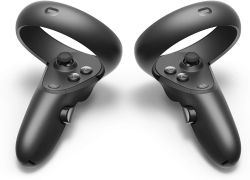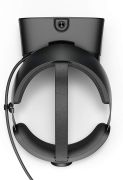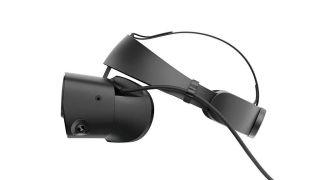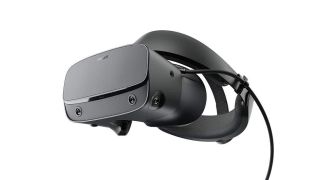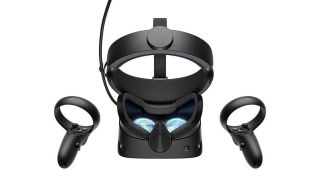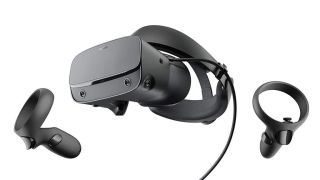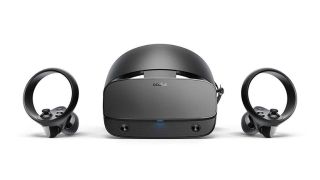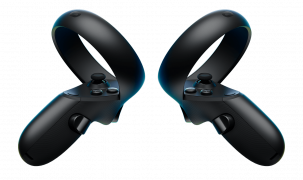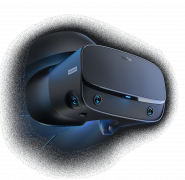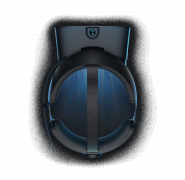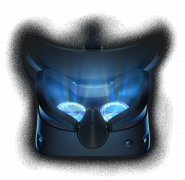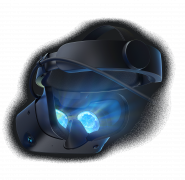Oculus Rift S
| Oculus Rift S | |
|---|---|
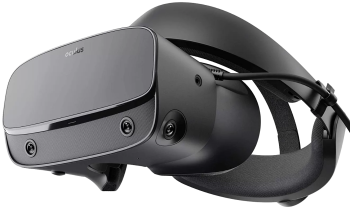
| |
| Basic Info | |
| VR/AR | Virtual Reality |
| Type | Head-mounted display |
| Subtype | PC-Powered VR |
| Platform | Oculus Rift (Platform) |
| Developer | Oculus VR, Lenovo |
| Manufacturer | Lenovo |
| Announcement Date | March 20, 2019 |
| Release Date | May 21, 2019 |
| Price | $399 |
| Website | https://www.oculus.com/rift-s/ |
| Requires | VR-Ready PC |
| Predecessor | Oculus Rift CV1 |
| Successor | Rift line discontinued |
| System | |
| Operating System | Windows 10 |
| Storage | |
| Display | |
| Display | Fast-switch LCD |
| Resolution | 2560×1440 (1280×1440 per eye) |
| Refresh Rate | 80Hz |
| Image | |
| Field of View | 115° |
| Foveated Rendering | No |
| Optics | |
| Optics | Next generation lenses (from Oculus Go) |
| IPD Range | Fixed at 63.5mm (software adjustment only) |
| Adjustable Diopter | No |
| Passthrough | Passthrough+ |
| Tracking | |
| Tracking | Inside-out tracking, (6DOF) |
| Base Stations | None (Inside-out tracking) |
| Rotational Tracking | Yes |
| Positional Tracking | Oculus Insight |
| Play Space | Room‑scale, 9ft x 9ft |
| Audio | |
| Audio | Integrated in strap |
| Microphone | Yes |
| 3.5mm Audio Jack | Yes |
| Camera | 5 tracking cameras (2 front, 1 on each side, 1 on top) |
| Connectivity | |
| Connectivity | DisplayPort 1.2, USB 3.0 |
| Ports | DisplayPort 1.2, USB 3.0, 3.5mm audio jack |
| Wired Video | DisplayPort 1.2 |
| Power | USB powered |
| Device | |
| Dimensions | 10.94 x 6.3 x 8.27 inches |
| Weight | 500g |
| Headstrap | Halo design with integrated audio |
| Color | Black |
| Sensors | 5 |
| Input | Oculus Touch |
| Size | 10.94 x 6.3 x 8.27 inches |
| Cable Length | 5 meters |
The Oculus Rift S is a PC-powered VR headset developed by Oculus VR in partnership with Lenovo. Announced during GDC 2019 on March 20, 2019, and released on May 21, 2019, it served as the successor to the original Oculus Rift CV1.[1] The Rift S featured several improvements over its predecessor, including a higher resolution display, improved lenses, and a new inside-out tracking system called Oculus Insight that eliminated the need for external sensors.[2] The headset was discontinued in April 2021 in favor of the Meta Quest 2.[3]
Design and Hardware
Display and Optics
The Rift S featured a single fast-switch LCD panel with a resolution of 2560×1440 (1280×1440 per eye), an upgrade from the Rift CV1's dual OLED displays with 1080×1200 per eye resolution.[4] While the resolution was improved, the refresh rate was reduced from 90Hz on the original Rift to 80Hz on the Rift S. The field of view was approximately 115 degrees, a slight increase from the 110 degrees on the Rift CV1.[2]
The Rift S utilized "next generation" lens technology that was first introduced in the Oculus Go. These improved lenses significantly reduced the "god rays" (lens flare artifacts) that were common in the original Rift.[2]
Unlike the Rift CV1, the Rift S did not feature mechanical interpupillary distance (IPD) adjustment. Instead, it used a fixed lens spacing of approximately 63.5mm with software-based IPD adjustment.[5] This meant that users with IPD measurements significantly different from the average might experience some visual discomfort or reduced clarity.[6]
Headstrap and Comfort
The Rift S featured a halo-style headband, co-designed with Lenovo, which differed significantly from the Rift CV1's strap system. According to Oculus, this new design provided better weight distribution, improved light blocking, and increased comfort during extended use.[2] The headset included a knob at the rear of the band to adjust fit and a button underneath the right side that allowed users to adjust the distance between the headset and their face.[2]
Audio
Unlike the Rift CV1 which featured integrated headphones, the Rift S incorporated speakers into the headband, similar to the Oculus Go and Oculus Quest. This design allowed users to hear both VR audio and their surroundings simultaneously. For those preferring a more immersive audio experience, the headset included a 3.5mm audio jack for connecting external headphones.[7]
Tracking System
One of the most significant changes in the Rift S was the adoption of the Oculus Insight inside-out tracking system, also used in the Oculus Quest. This system used five cameras built into the headset (two on the front, one on each side, and one on top) to track both the user's movements and the Oculus Touch controllers.[8]
The Insight tracking system eliminated the need for external sensors, simplifying the setup process and allowing for a more flexible play area. The Rift S included an additional fifth camera over the Quest's four-camera setup to improve compatibility with existing Oculus Rift software and provide a wider tracking range.[2]
Controllers
The Rift S used the second generation Oculus Touch controllers, the same as those used with the Oculus Quest. These controllers featured a redesigned tracking ring positioned on top (rather than underneath as in the first generation) to facilitate tracking by the headset's cameras.[9] Each controller included an analog stick, buttons, and triggers for intuitive interaction in VR environments.[9]
Passthrough+
The Rift S introduced Passthrough+, an enhanced version of the standard passthrough feature found in other VR headsets. Passthrough+ used the headset's front-facing cameras to show the user's surroundings in monochromatic (black and white) view, allowing users to see their environment without removing the headset.[10]
Passthrough+ utilized Asynchronous SpaceWarp (ASW) technology to create a comfortable stereo-correct view with minimal depth disparity and performance impact. It was automatically activated when users stepped outside their designated Guardian boundaries or could be manually enabled through the Oculus interface.[2]
Software
The Rift S was compatible with all software developed for the original Rift, including games, experiences, and applications available on the Oculus Store. Additionally, the Rift S supported third-party VR content through platforms like SteamVR.[11]
Oculus Home and Dash
Like its predecessor, the Rift S utilized the Oculus Home environment as a central hub for accessing content and socializing with friends. The Dash interface allowed users to access their PC desktop and applications while in VR.[12]
Cross-Buy Support
The Oculus Store offered cross-buy support between the Rift S and Oculus Quest for compatible titles, allowing users who owned both headsets to purchase a game once and play it on either platform.[2]
PC Requirements
Recommended Specifications
| Component | Specification |
|---|---|
| Graphics Card | NVIDIA GTX 1060 / AMD Radeon RX 480 or greater |
| Alternative Graphics Card | NVIDIA GTX 970 / AMD Radeon R9 290 or greater |
| CPU | Intel i5-4590 / AMD Ryzen 5 1500X or greater |
| Memory | 8GB+ RAM |
| Video Output | DisplayPort 1.2 / Mini DisplayPort (with adapter included in box) |
| USB Ports | 1x USB 3.0 port |
| Operating System | Windows 10 |
Compared to the original Rift, the Rift S maintained similar PC requirements despite the higher resolution display. This was achieved through the use of similar default render resolution and a slightly lower refresh rate (80Hz vs. 90Hz).[14]
Setup Process
Setting up the Rift S was simplified compared to the original Rift due to the inside-out tracking system:
- Download the Oculus software from the official website
- Connect the Rift S headset to your PC using the provided DisplayPort and USB 3.0 cables
- Follow the on-screen instructions to complete the setup and define your play area
- Browse the Oculus library for games and experiences[15]
Input Devices
The primary input devices for the Rift S were the second-generation Oculus Touch controllers. These ergonomic controllers translated hand and finger movements into VR and provided haptic feedback for a more immersive experience.[16]
Each Touch controller required one AA battery and featured:
- An analog thumbstick
- Two face buttons
- A trigger button
- A grip button
- A system button
- Capacitive sensors for finger presence detection[9]
Accessories
Prescription Lenses
Users with vision correction needs could purchase prescription lens inserts for the Rift S. VirtuClear® Lens Inserts were available through Frames Direct and featured 1.60 Hi Index Essilor lenses with anti-reflective coating. The prescription range supported was SPH: 0 to -8.0 | CYL: 0 to -2.0.[17]
Third-Party Accessories
Various third-party accessories were available for the Rift S, including:
- Replacement face covers and padding
- Cable management solutions
- Display port extension cables
- Protective covers and travel cases
- Alternative audio solutions
Development
The Rift S was co-developed by Oculus VR and Lenovo. The partnership with Lenovo incorporated their experience in VR/AR hardware design and feedback from the Lenovo Legion gaming community.[2]
Developers could create content for the Rift S using the Oculus SDK, which provided tools and resources for VR development. The SDK integrated with popular game engines like Unity, Unreal Engine, and CryEngine.[18]
History
- June 2015: Palmer Luckey, co-founder of Oculus VR, revealed that Oculus was working on a successor to the original Rift.[2]
- October 2018: Brendan Iribe, co-founder and former CEO of Oculus VR, left the company reportedly due to the cancellation of a "Rift 2" project and differences in vision for the future of Oculus.[19]
- March 20, 2019: The Oculus Rift S was officially announced at GDC 2019.[1]
- May 21, 2019: The Rift S was released to the public at a price of $399.[20]
- April 2021: Production of the Rift S was discontinued.[3]
- June 2021: The Rift S section was removed from the Oculus website, and the headset was no longer being sold.[2]
Reception
The Rift S received mixed reviews from critics and users. While the headset was praised for its improved resolution, simplified setup process, and comfortable halo strap design, it was also criticized for certain design choices that some considered downgrades from the original Rift.
Positive Reception
- The Oculus Insight tracking system was well-received for its accuracy and ease of setup, eliminating the need for external sensors.[21]
- The higher resolution display provided improved visual clarity and reduced the "screen door effect" compared to the original Rift.[22]
- The halo strap design was comfortable for many users, particularly during extended VR sessions.[23]
- Passthrough+ was praised as a useful safety feature and convenience for briefly interacting with the real world.[10]
Criticisms
- The lack of hardware IPD adjustment was a significant issue for users with IPD measurements outside the average range.[6]
- The switch from OLED to LCD displays resulted in less vibrant colors and weaker black levels.[22]
- The reduction in refresh rate from 90Hz to 80Hz was noticeable to some users and potentially contributed to motion sickness for sensitive individuals.[2]
- The built-in audio solution was considered inferior to the integrated headphones of the original Rift.[21]
Overall, the Rift S was viewed as an incremental upgrade rather than a revolutionary advancement in PC VR technology.[2]
Legacy
The Rift S represented the final iteration in the PC-tethered Oculus Rift line. Following its discontinuation in 2021, Facebook (now Meta) shifted its focus to standalone VR headsets with the Meta Quest line, which can optionally connect to PCs via Oculus Link to play PC VR content.[3]
Many of the technologies pioneered or improved in the Rift S, such as the Oculus Insight tracking system and the improved lens design, have continued to influence subsequent VR headsets from Meta and other manufacturers.
Technical Specifications
| Feature | Specification |
|---|---|
| Display | Single fast-switch LCD |
| Resolution | 2560×1440 (1280×1440 per eye) |
| Refresh Rate | 80Hz |
| Field of View | Approximately 115° |
| Tracking | 6 degrees of freedom (6DOF) |
| Tracking System | Oculus Insight (inside-out) |
| Cameras | 5 (2 front, 1 on each side, 1 on top) |
| Controllers | Oculus Touch (second generation) |
| Audio | Integrated spatial audio in headband, 3.5mm audio jack |
| Microphone | Integrated |
| Connectivity | DisplayPort 1.2, USB 3.0 |
| Cable Length | 5 meters |
| Weight | Approximately 500g |
| Dimensions | 10.94 x 6.3 x 8.27 inches |
| IPD Adjustment | Software only (fixed physical IPD of 63.5mm) |
| Recommended Play Space | Up to 9ft x 9ft |
Images
References
- ↑ 1.0 1.1 https://www.theverge.com/2019/3/20/18273152/oculus-rift-s-vr-headset-announced-pricing-release-date-features-gdc-2019
- ↑ 2.00 2.01 2.02 2.03 2.04 2.05 2.06 2.07 2.08 2.09 2.10 2.11 2.12 https://en.wikipedia.org/wiki/Oculus_Rift_S
- ↑ 3.0 3.1 3.2 https://www.theverge.com/2020/9/16/21422717/facebook-oculus-rift-s-discontinued-quest-2-vr-connect
- ↑ https://vr-compare.com/headset/oculusrifts
- ↑ https://www.roadtovr.com/oculus-rift-s-supported-ipd-range-fov-quest-go/
- ↑ 6.0 6.1 https://www.roadtovr.com/palmer-luckey-oculus-founder-rift-s-optimal-70-population-ipd/
- ↑ https://www.uploadvr.com/oculus-rift-s-official/
- ↑ https://www.uploadvr.com/oculus-insight-christmas-tree-patch/
- ↑ 9.0 9.1 9.2 https://en.wikipedia.org/wiki/Oculus_Touch
- ↑ 10.0 10.1 https://www.uploadvr.com/oculus-rift-s-official/
- ↑ https://www.theverge.com/2019/3/20/18273152/oculus-rift-s-vr-headset-announced-pricing-release-date-features-gdc-2019
- ↑ https://www.oculus.com/rift-s/features/
- ↑ https://www.oculus.com/rift-s/
- ↑ https://venturebeat.com/games/oculus-rift-s-has-a-well-hidden-resolution-setting/
- ↑ https://www.oculus.com/setup/#rift-s-setup
- ↑ https://www.oculus.com/rift-s/features/
- ↑ https://www.framesdirect.com/virtuclear-lens-inserts-for-oculus-rift-s.html
- ↑ https://developer.oculus.com/documentation/native/pc/dg-input-touch-overview/?locale=en_US
- ↑ https://en.wikipedia.org/wiki/Oculus_Rift_S
- ↑ https://www.theverge.com/2019/3/20/18273152/oculus-rift-s-vr-headset-announced-pricing-release-date-features-gdc-2019
- ↑ 21.0 21.1 https://www.theverge.com/2019/3/20/18273152/oculus-rift-s-vr-headset-announced-pricing-release-date-features-gdc-2019
- ↑ 22.0 22.1 https://www.kitguru.net/tech-news/featured-tech-news/matthew-wilson/oculus-rift-s-specifications-and-differences-compared-to-cv1/
- ↑ https://www.scan.co.uk/products/oculus-rift-s-virtual-reality-headset-and-touch-controllers-for-mind-blowing-pc-vr-gaming



